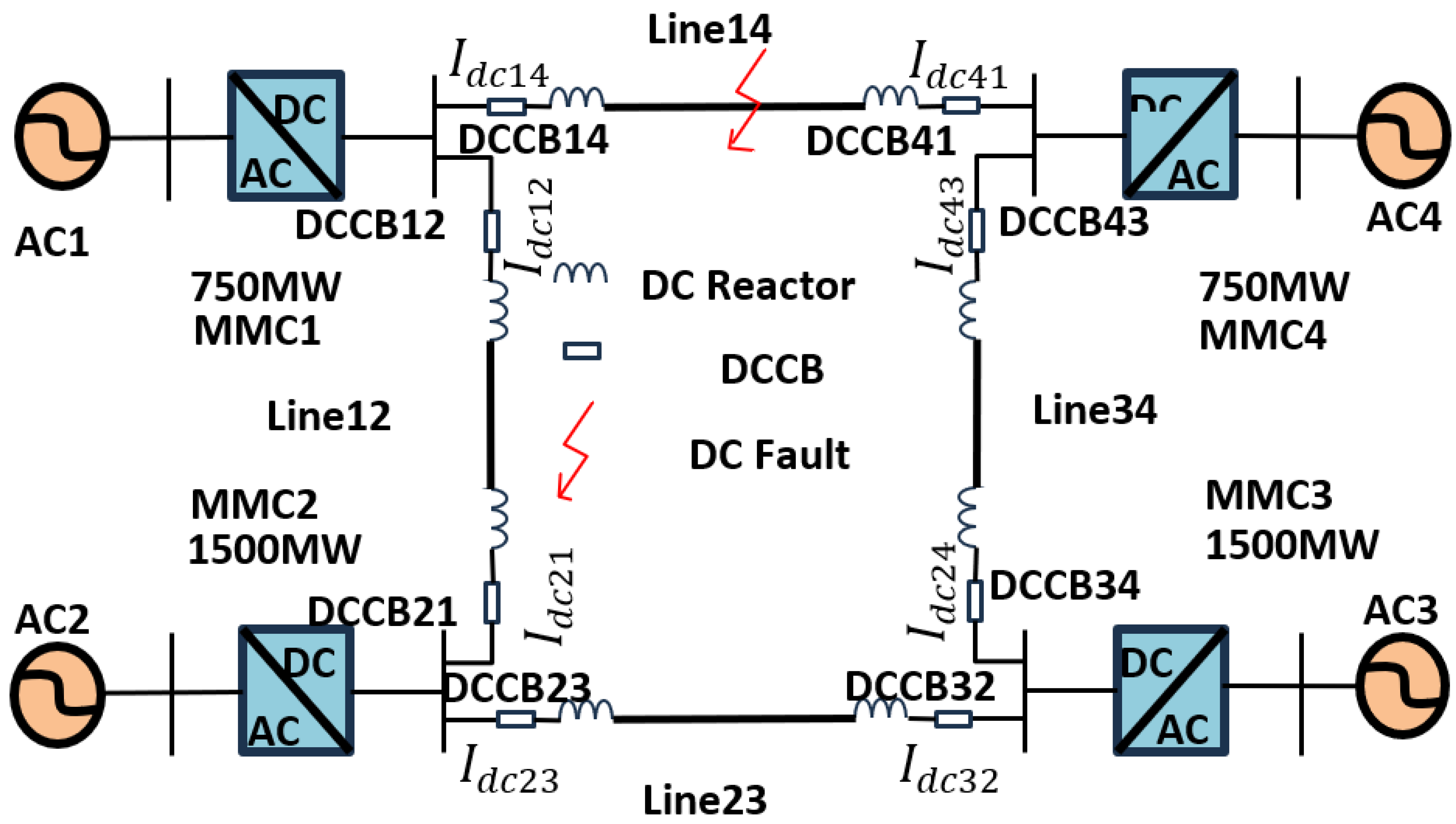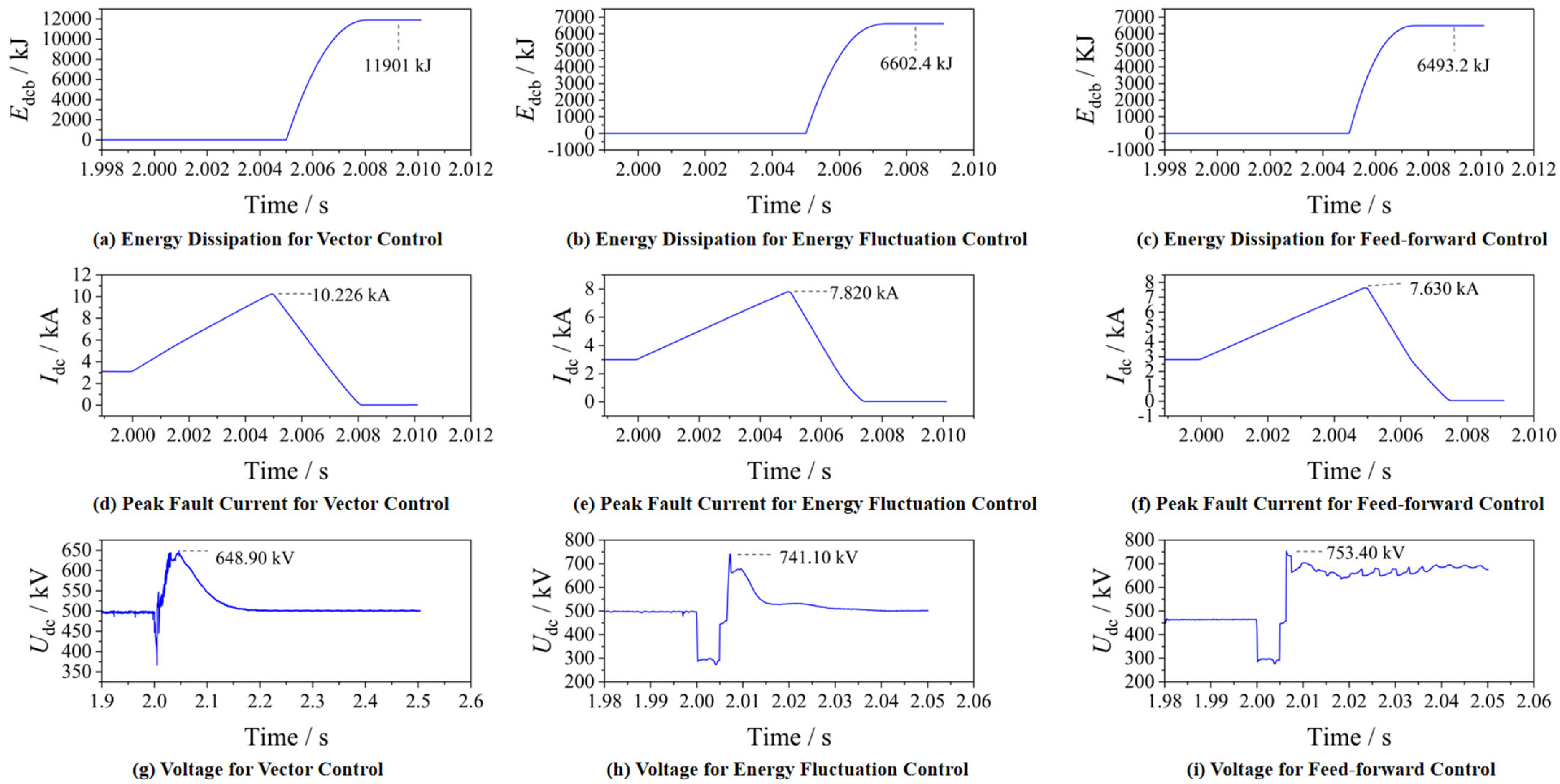Study of Energy Flow Mechanisms in High Power Device Converters
Abstract
:1. Introduction
2. Flexible DC Transmission System Energy Control
2.1. Traditional MMC Energy Control
2.2. Three Dimensional Energy Control Design
- Constant power station control
3. Energy Fluctuation Control
- (a)
- Energy control for fixed power stations
- (b)
- Fixed DC voltage station control
4. Feed-Forward Energy Control
5. Validate
5.1. Simulation Results of Energy Fluctuation Control
5.2. Simulation Results of Re-Energy Fluctuation Control
6. Conclusions
- (1)
- These two control strategies can be applied to the converter topology containing independent sub-modules, limiting the fault current by temporarily reducing the number of sub-module inputs. Also, these two strategies can decouple the sub-module capacitance voltage and DC line output voltage control. The peak values of DC current, DC voltage and energy loss for energy control are reduced.
- (2)
- Through the simulation, this paper compares the suppression effect of feedforward control and direct energy control on the energy peak after the fault occurs. When a DC short-circuit fault occurs, the feedforward control can suppress the energy peak within 5 ms to 6.493 MJ, which is 45.43% less than the conventional vector control. The feedforward control can suppress the peak current to 7.630 KA, compared with the conventional vector control peak current of 10.266 KA, the peak current is reduced by 25.38%. The energy peak within 5 ms of direct energy control in the same case is 6.602 MJ, which is 44.53% less than the conventional vector control. The direct energy control can suppress the peak current to 7.820 KA, compared with the conventional vector control peak current of 10.266 KA, the peak current is reduced by 23.52%. Compared with direct energy control, the peak energy consumption of the arrester is reduced by 1.01%, and the peak fault current is reduced by 1.86%. Thus, the feed-forward energy control is better than direct energy control.
- (3)
- Compared with the traditional three-dimensional energy control, the energy fluctuation control is significantly better than the conventional vector control, and the feedforward energy control further reduces the energy peak on this basis. The peak capacity is reduced by 45.43% compared with the conventional energy control, and the peak current is reduced by 25.39%, which reduces the breaking capacity and the difficulty of the design of the DCCB and saves the cost of the equipment.
Author Contributions
Funding
Data Availability Statement
Conflicts of Interest
References
- Lu, X.; Xiang, W.; Lin, W.; Wen, J. Stability analysis and control parameter optimization for hybrid modular multilevel converter connected to weak AC system. Autom. Electr. Power Syst. 2020, 44, 70–78. [Google Scholar]
- Zama, A.; Benchaib, A.; Bacha, S.; Frey, D.; Silvant, S.; Georges, D. Linear Feedback Dead-Beat Control for Modular Multilevel Converters: Validation Under Faults Grid Operation Mode. IEEE Trans. Ind. Electron. 2021, 68, 3181–3191. [Google Scholar] [CrossRef]
- Wang, S.; Zhou, X.; Tang, G.; He, Z.; Teng, L.; Liu, J. Selection and calculation for sub-module capacitance in modular multi-level converter HVDC power transmission system. Power Syst. Technol. 2011, 35, 26–32. [Google Scholar]
- Xin, B.; Guo, M.; Wang, S.; Li, X. Friendly HVDC transmission technologies for large-scale renewable energy and their engineering practice. Autom. Electr. Power Syst. 2021, 45, 1–8. [Google Scholar]
- Liu, Z.; Guo, X. Operating characteristics research and engineering application of voltage source converter based DC grid with renewable source connected. Power Syst. Technol. 2020, 44, 3595–3603. [Google Scholar]
- Cheng, X.; Gu, Q.; Ren, X.; Zheng, C.; Huang, T.; Zhang, B. Adaptability analysis on differential protection of converter transformers in a VSC-HVDC transmission system connected to offshore wind farms. Zhejiang Electr. Power 2024, 43, 8–18. [Google Scholar] [CrossRef]
- Mei, N.; Zhou, Y.; Li, T.; Yuan, B. Energy consumption method for power surplus in Zhangbei VSC-based DC grid. Power Syst. Technol. 2020, 44, 1991–1999. (In Chinese) [Google Scholar]
- Cai, W.; Zhao, Y.; Hu, Y.; Zhang, J.; Peng, L.; Fan, W. Simulation of operation characteristics of AC energy dissipation device in Zhangbei flexible DC grid. Power Capacit. React. Power Compens. 2021, 42, 65–71. (In Chinese) [Google Scholar]
- Guo, X.; Liu, B.; Mei, H.; Liu, J.; Yu, H.; Cao, F. Analysis and suppression of resonance between AC and DC systems and suppression of resonance between AC and DC systems in Chongqing-Hubei back-to-back HVDC project of China in Chongqing-Hubei back-to-back HVDC project of China. Autom. Electr. Power Syst. 2020, 44, 157–164. [Google Scholar]
- Ji, K.; Tang, G.F.; Pang, H.; Yang, J. Impedance modelling and analysis of MMC-HVDC for offshore wind farm integration. IEEE Trans. Power Deliv. 2020, 35, 1488–1501. [Google Scholar] [CrossRef]
- Ma, X.J.; Teng, J.Y.; Yao, T. Capacitor voltage balancing control of modular multilevel converter based on circling control of modular multilevel converter based on circulation current suppression strategy culation current suppression strategy. Control. Eng. China 2019, 26, 1745–1750. (In Chinese) [Google Scholar]
- Li, Z.; Hao, Q.R.; Gao, F.; Guan, M. Nonlinear decoupling control of two-terminal MMC—HVDC based on feedback line arisation. IEEE Trans. Power Deliv. 2019, 34, 376–386. [Google Scholar] [CrossRef]
- Zhang, J.P.; Hu, Z.W.; Tian, X.C. Research on MMC-HVDC multi-objective model predictive control strategy under asymmetric faults. Energy Rep. 2020, 6, 430–439. [Google Scholar] [CrossRef]
- Lv, J.; Cai, X.; Zhang, Z.; Chi, Y. Impedance Modeling and Stability Analysis of MMC-based HVDC for Offshore Wind Farms. Proc. CSEE 2016, 36, 3771–3781. [Google Scholar]
- Li, Y.F.; An, T.; Zhang, D.; Pei, X. Analysis and suppression control of high frequency resonance for MMC-HVDC.sion control of high frequency resonance for MMC-HVDC system. IEEE Trans. Power Deliv. 2021, 36, 3867–3881. [Google Scholar] [CrossRef]
- Liang, S.; Tian, J.; Cao, D.; Dong, Y.; Zhang, J. A control and protection scheme for HVDC system. Autom. Electr. Power Syst. 2013, 37, 59–65. (In Chinese) [Google Scholar]
- Bergna, G.; Berne, E.; Egrot, P.; Lefranc, P.; Arzandé, A.; Vannier, J.C.; Molinas, M. An energy-based controller for HVDC modular multilevel converter in decoupled double synchronous refee for voltage oscillation reduction. IEEE Trans. Ind. Electron. 2013, 60, 2360–2371. [Google Scholar] [CrossRef]
- Guo, X.; Cui, X.; Qi, L. DC Short-circuit Fault Analysis and Protection for the Overhead Line Bipolar MMC-HVDC System. Proc. CSEE 2017, 37, 2177–2184. [Google Scholar]
- Enric, S.; Eduardo, P.; Oriol, G. The Role of the Internal Energy in MMCs Operating in Grid-Forming Mode. IEEE J. Emerg. Sel. Top. Power Electron. 2020, 8, 949–962. [Google Scholar]
- Mukherjee, S.; Galigekere, V.P.; Onar, O.; Ozpineci, B. DC Link Capacitor Reduction with Feedforward Control in Series-Series Compensated Wireless Power Transfer Systems. In Proceedings of the 2020 IEEE Applied Power Electronics Conference and Exposition (APEC), New Orleans, LA, USA, 15–19 March 2020. [Google Scholar]
- Reyes-Zamora, R.A.; Rosales-Escobedo, P.F.; Castro, L.M.; Paniagua-Ramirez, J.; Ruelas, A.; Acuña, A.; Suastegui, J.A. Suastegui Modelling of renewable power plant controllers for steady-state studies using an extended power flow formulation. Int. J. Electr. Power Energy Syst. 2022, 141, 108185. [Google Scholar] [CrossRef]
- Jo, Y.-J.; Nguyen, T.H.; Lee, D.-C. Capacitance Estimation of the Submodule Capacitors in Modular Multilevel Converters for HVDC Applications. J. Power Electron. 2016, 16, 1752–1762. [Google Scholar] [CrossRef]
- Wang, Z.; Lin, H.; Ma, Y. A control strategy for a modular multilevel inverter with integrated battery energy storage based on on Battery Side Capacitor Voltage Control. Energies 2019, 12, 2151. [Google Scholar] [CrossRef]
- Zhao, X.; Chen, L.; Li, G.; Xu, J.; Yuan, J. Coordination Method for DC Fault Current Suppression and Clearance in DC Grids. CSEE J. Power Energy Syst. 2022, 8, 1438–1447. [Google Scholar]
- Braeckle, D.; Himmelmann, P.; Gröll, L.; Hagenmeyer, V.; Hiller, M. Energy Pulsation Reduction in Modular Multilevel Converters Using Optimized Current Trajectories. IEEE Open J. Power Electron. 2021, 2, 171–186. [Google Scholar] [CrossRef]
- Ni, B.; Xiang, W.; Zhou, M.; Zuo, W.; Yao, W.; Lin, W.; Wen, J. An adaptive fault current limiting control for MMC and its application in DC grid. IEEE Trans. Power Deliv. 2021, 36, 920–931. [Google Scholar] [CrossRef]
- Wang, J.; Ma, H.; Bai, Z.H. A submodule fault ride-through strategy for modular multilevel converters with nearest level modulation. IEEE Trans. Power Electron. 2018, 33, 1597–1608. [Google Scholar] [CrossRef]
- Li, E.; Ma, K.; Cai, X. Operating condition simulation test method for sub-modules of modular multilevel converter. Autom. Electr. Power Syst. 2022, 46, 132–142. [Google Scholar]
- Freytes, J.; Bergna, G.; Suul, J.A.; D’Arco, S.; Gruson, F.; Colas, F.; Saad, H.; Guillaud, X. Improving Small-Signal Stability of an MMC With CCSC by Control of the Internally Stored Energy. IEEE Trans. Power Deliv. 2018, 33, 429–439. [Google Scholar] [CrossRef]
- Freytes, J.; Akkari, S.; Rault, P.; Belhaouane, M.M.; Gruson, F.; Colas, F.; Guillaud, X. Dynamic Analysis of MMC-Based MTDC Grids: Use of MMC Energy to Improve Voltage Behavior. IEEE Trans. Power Deliv. 2019, 34, 137–148. [Google Scholar] [CrossRef]
- Li, J.; Li, V.; Liu, X.; Jin, H.; Zhang, Z. Application of HVDC Circuit Breaker in Zhangbei Flexible DC Power Grid. Northeast. Electr. Power Technol. 2024, 45, 25–29. (In Chinese) [Google Scholar]




| Converter Station | Number of Submodules | Submodule Capacitance/μF | Bridge Reactance/mH | Control Strategy |
|---|---|---|---|---|
| MMC1 | 250 | 7500 | 100 | P = −1500 MW Q = 0 MVar |
| MMC2 | 250 | 15,000 | 75 | P = 750 MW Q = 0 MVar |
| MMC3 | 250 | 15,000 | 75 | P = 1500 MW Q = 0 MVar |
| MMC4 | 250 | 7500 | 100 | Udc = 500 kV Q = 0 MVar |
| Parameters | Value | Parameters | Value |
|---|---|---|---|
| MMC Capacity/MW | 1800 | Transformer capacity/MVA | 1800 |
| Number of submodules | 250 | DC line reactance/H | 0.15 |
| DC voltage/kV | 500 | Transformer ratio/kV | 530/210 |
| Submodule capacity/mF | 7.5 | Bridge reactance/H | 0.1 |
| Parameters | Vector Control | Energy Fluctuation Control | Feed-Forward Control |
|---|---|---|---|
| Energy Dissipation/kJ | 11,901 | 6602.4 | 6493.2 |
| Peak Fault Current/kA | 10.226 | 7.820 | 7.630 |
| Voltage/kV | 648.90 | 741.10 | 753.40 |
Disclaimer/Publisher’s Note: The statements, opinions and data contained in all publications are solely those of the individual author(s) and contributor(s) and not of MDPI and/or the editor(s). MDPI and/or the editor(s) disclaim responsibility for any injury to people or property resulting from any ideas, methods, instructions or products referred to in the content. |
© 2024 by the authors. Licensee MDPI, Basel, Switzerland. This article is an open access article distributed under the terms and conditions of the Creative Commons Attribution (CC BY) license (https://creativecommons.org/licenses/by/4.0/).
Share and Cite
Zhao, Z.; Jin, Q.; Wu, Y.; Li, G.; Xiang, T. Study of Energy Flow Mechanisms in High Power Device Converters. Energies 2024, 17, 1980. https://doi.org/10.3390/en17081980
Zhao Z, Jin Q, Wu Y, Li G, Xiang T. Study of Energy Flow Mechanisms in High Power Device Converters. Energies. 2024; 17(8):1980. https://doi.org/10.3390/en17081980
Chicago/Turabian StyleZhao, Zheyuan, Qianzheng Jin, Yingjie Wu, Gen Li, and Tiange Xiang. 2024. "Study of Energy Flow Mechanisms in High Power Device Converters" Energies 17, no. 8: 1980. https://doi.org/10.3390/en17081980






